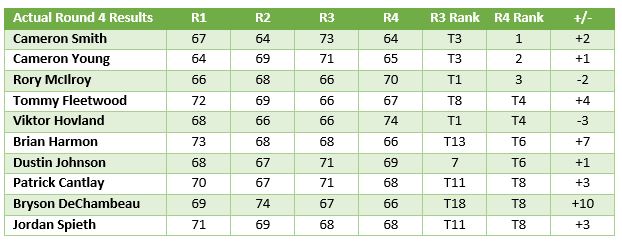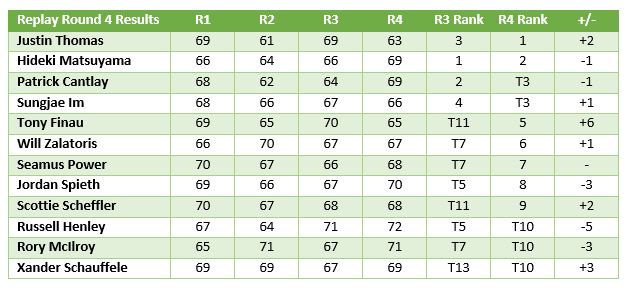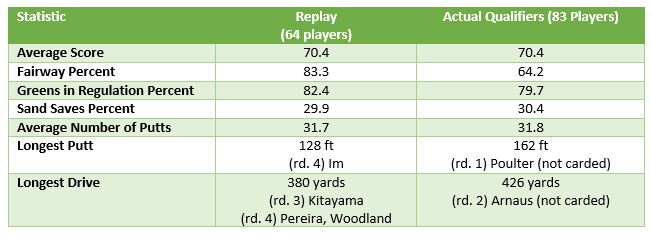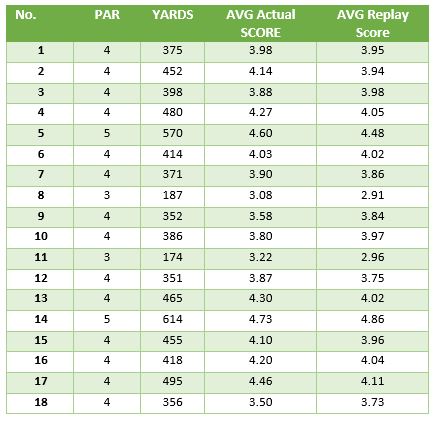My four-round, 64-golfer simulation of the 2022 Open Championship wrapped up this past weekend. Before I tell you who won, let me say that some of the statistical comparisons between the actual event and the replay are amazing. More on that below.
In previous posts, I have documented the tournament’s earlier round results and how the Game Caddie was adapted for use with Birthplace (APBA’s rendering of St. Andrews). To make the replay faster, new wind management features were added to the Game Caddie (v. 5.2). These include automatic dice rolls for wind and a much easier way to enter hole wind data from the Birthplace course boards for each shot. I’ll discuss more about the replay, but first let’s look at the final round of the actual tournament.
Actual Event
Cameron Smith started the day four strokes behind the third-round leaders, Viktor Hovland and Rory McIlroy. Smith finished 20-under par and went on to win by one stroke over Cameron Young (-19) and two strokes over Rory McIlroy (-18). Smith’s round score of 64 included eight birdies. At 20-under par, Smith matched the lowest score of any Major tournament (relative to par) –a record also held by Jason Day (PGA-Whistling Straights, 2015), Henrik Stenson (Open Championship-Royal Troon, 2016) and Dustin Johnson (Masters-Augusta National, 2020).
One of Smith’s defining shots that day was on the ‘road hole’, number 17, where he used his putter from behind its dangerous green-side bunker to snake a putt around the trap to within 12 feet of the pin. From there, he drained the putt to save par. Though Cameron Young (65) would eagle number 18, it wasn’t enough to catch Smith and finished second.
Posting final day rounds of 66, Bryson DeChambeau tied for eighth place and Brian Harmon tied for sixth. Tommy Fleetwood (67) tied for fourth place with Viktor Hovland (74). With final round scores of 68, Patrick Cantlay and Jordan Spieth ended up tied for eighth with DeChambeau. Rory McIlroy (70) slipped to third place. A summary of the actual leaderboard is provided below:

Replay Results
In the final round of the replay, winds were Calm, conditions Hard (+20 FW/+10 Green roll), and the pin was located at position 4. At the end of my round 3 replay, Hideki Matsuyama (-20) led Patrick Cantlay (-18) by two strokes and Justin Thomas (-17) by three. Sungjae Im (-15) trailed by five strokes. Jordan Spieth (-14) and Russell Henley (-14) started six back.
With record-breaking low scores atop the replay leaderboard, no lead was safe. Much like the actual event, the ideal scoring conditions for the final round and tight leaderboard demanded that a player “go low or go home.” That made a bit of risk-taking and pin-seeking the order of the day. The “Clutch” rule was put into effect on the last three holes for the top 10 finishers of the previous round. That also encouraged some risk-taking on longer putts on the closing holes.
Although Matsuyama held a 3-stroke advantage, the 54-hole leader needed a top score on the final round to ensure holding off the potential threats posed by Patrick Cantlay (68, 62, 68) and Justin Thomas (69, 61, 69). Both players had demonstrated an ability to go very low in earlier rounds. For instance, Thomas’s 61 in round 2 had already earned him a tie for best round score ever in my own history of tournament replays. Only Bryson DeChambeau had a tournament score as low (in my 2020 Players Championship replay). Nearly as dangerous, Patrick Cantlay shot a round 2 score of 62.
By way of a little background, Thomas’s accomplishment exceeded the actual Open performance record by shooting one stroke better than Brandon Grace, who set the all-time record of 62 at Royal Birkdale in 2017. It was also two strokes better than Rory McIlroy’s 63, which is the St. Andrews Open record set in 2020. Thomas’s 61 also matched Ross Fisher, who holds the course record for lowest round score at St. Andrews in competition (Alfred Dunhill Link Championship, 2015).
While the last pairing, Matsuyama and Cantlay, both shot 3-under par to finish out the tournament, Thomas overtook both of them with a flawless final round of 63. Thomas’s scorecard featured no bogies, 9 birdies (two of which came from chip-ins), and a mere 24 putts. On the back nine, Thomas closed the door on his fellow competitors by making birdies on five holes in a row (holes 12 – 16), scrambled to save par on number 17, and two-putted to make par on 18. This remarkable back-nine charge earned him the virtual Claret Jug trophy for my 2022 Open Championship replay.
Honorable mention goes to Tony Finau, who finished with a 65. He chipped in for par on the first hole, followed by 7 birdies and no bogies.
Also worthy of honorable mention is Sungjae Im, who turned in a final round 66. The highlights of Im’s round included an eagle on number 5 (sinking a replay record putt of 128 feet) and a hole-out on his second shot on par 4 number 10.
Other kudos in round 4 go to Xander Schauffele and Tom Hoge for acing the par 3 number 11.
Although Cameron Smith began the day tied for 7th place, he did not make the replay Top 10 leaderboard at the end of the final round. Smith ran afoul of sand on number 13. After his errant drive found a fairway bunker, he took three swipes to get out–only to come to rest in a deep green-side bunker! His first attempt to escape failed, but he did manage to put the ball on the green on his next shot. Two putts later Smith’s ball found the hole (and a snowman) for an ugly 8. He finished the replay with a disappointing round of 75 (+3) and tied for 18th place (-10).
To recap: Justin Thomas finished atop the replay leaderboard at 26-under par. Hideki Matsuyama was three back at 23-under. Patrick Cantlay and Sungjae Im both finished 5 back at 21-under. Thus, in this tournament replay a total of four competitors beat the all-time actual Major tournament record score of 20-under par. A summary of the replay leaderboard is provided below:2

A Comparison of Overall Actual and Replay Results
Despite the outstanding performances of Thomas, Matsuyama, Cantlay, and Im, the overall replay field performed on average almost the same as the actual players. The average round scores for replay golfers and actual qualifiers matched exactly (70.4). Putts per round (using the Major Tournament Putting Boards) were also nearly an exact match between the two groups. Play from the sand was very similar, too.
Only the fairway percentage stat was obviously better for the replay group. Despite that, Greens in Regulation percentages were still quite close. While this replay group drove the ball farther and sunk longer putts than in any of my previous simulated tournaments, no replay golfer could match the longest drives or putt distances of the actual qualifiers.

A Comparison of Hole Difficulty Between the Actual and Replay Events
As with the overall average score, a hole-by-hole comparison of scores between the actual and replay events matched closely as well. The easiest holes in both cases were the two par 5’s (#5 and #14). Number 17, the road hole, proved most difficult for both groups.
Holes 11, 13, and 16 played somewhat harder for the actual players. Number 9 was not as easy for the replay golfers as it was for the actual players.
Taken together, these data suggest that the APBA rendition of St. Andrews (Birthplace) held up well in terms of realism when using similar wind and course conditions for both groups. For more about those conditions, see my post on Setting Up a Replay of the 2022 Open Championship.
Here is a hole-by-hole comparison of scores for the actual event and my replay tournament:

A complete set of final results for this tournament replay can be viewed by clicking on the PDF document below: